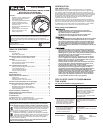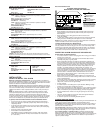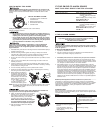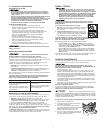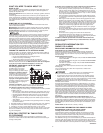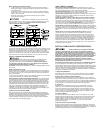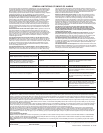
ABOU
T SMOKE ALARMS
Battery (DC) operated Smoke Alarms: Provide protection even when
ele
ctricity fails, provided the batteries are fresh and correctly installed. Units
ar
e easy to install, and do not require professional installation.
AC powered Smoke Alarms: Can be interconnected so if one unit senses
smo
ke, all units alarm.They do not operate if electricity fails.
A
C with battery (DC) back-up:
w
ill operate if electricity fails, provided the
batteries are fresh and correctly installed. AC and AC/DC units must be
i
nstalled by a qualified electrician.
Sm
oke/CO Alarms for Solar or Wind Energy users and battery backup
po
wer systems:
A
C powered Smoke/CO Alarms should only be operated
with true or pure sine wave inverters. Operating this Alarm with most battery-
po
wered UPS (uninterruptible power supply) products or square wave or
“
quasi sine wave” inverters
w
ill damage the Alarm
.
If you are not sure about
your inverter or UPS type, please consult with the manufacturer to verify.
Sm
oke Alarms for the hearing impaired:
Spe
cial purpose Smoke Alarms
shou
ld be installed for the hearing impaired.They include a visual alarm and
an audible alarm horn, and meet the requirements of the Americans With
D
isabilities Act. Can be interconnected so if one unit senses smoke, all units
a
larm.
Sm
oke alarms are not to be used with detector guards
u
nless the
combination has been evaluated and found suitable for that purpose.
Al
l these Smoke Alarms are designed to provide early warning of fires if
located, installed and cared for as described in the user’s manual, and if
smo
ke reaches the Alarm. If you are unsure which type of Smoke Alarm to
i
nstall, refer the National Fire Protection Association (NFPA) Standard 72
(National Fire Alarm Code) and NFPA 101 (Life Safety Code). National Fire
P
rotection Association, One Batterymarch Park, Quincy, MA 02269-9101.
L
oca
l building codes may also require specific units in new construction or
in different areas of the home.
S
PECIAL COMPLIANCE CONSIDERATIONS
T
his unit alone is not a suitable substitute for complete fire detection
systems in places housing many people—like apartment buildings,
condom
iniums, hotels, motels, dormitories, hospitals, long-term health
care facilities, nursing homes, day care facilities, or group homes of any
k
ind—even if they were once single-family homes. It is not a suitable
sub
stitute for complete fire detection systems in warehouses, industrial
facilities, commercial buildings, and special-purpose non-residential
buildings which require special fire detection and alarm systems.
Depending on the building codes in your area, this unit may be used to
provide additional protection in these facilities.
The following information applies to all five types of buildings listed below:
In new construction, most building codes require the use of AC or AC/DC
powered Smoke Alarms only.AC,AC/DC, or DC powered Smoke Alarms can be
used in existing construction as specified by local building codes. Refer to NFPA
72 (National Fire Alarm Code) and NFPA101 (Life Safety Code), local building
codes, or consult your Fire Department for detailed fire protection requirements
in buildings not defined as “households.”
1. Single-Family Residence:
Single family home, townhouse. It is recommended this unit be installed on
every level of the home, in every bedroom, and in each bedroom hallway.
2. Multi-Family or Mixed Occupant Residence:
Apartment building, condominium.This unit is suitable for use in individual
apartments or condos, provided a primary fire detection system already exists
to meet fire detection requirements in common areas like lobbies, hallways, or
porches. Using this unit in common areas may not provide sufficient warning
to all residents or meet local fire protection ordinances/regulations.
3. Institutions:
Hospitals, day care facilities, long-term health care facilities.This unit is
suitable for use in individual patient sleeping/resident rooms, provided a
pr
i
mary fire detection system already exists to meet fire detection require-
ments in common areas like lobbies, hallways, or porches. Using this unit in
common areas may not provide sufficient warning to all residents or meet
l
oca
l fir
e pr
o
t
ection ordinances/regulations.
4.
H
o
tels and M
otels:
Also bo
ar
d
i
ng houses and dormitories.This unit is suitable for use inside
individual sleeping/resident rooms, provided a primary fire detection system
already exists to meet fire detection requirements in common areas like
l
ob
b
ie
s
,
ha
llways, or porches. Using this unit in common areas may not
pr
ovide sufficient warning to all residents or meet local fire protection
ordinances/regulations.
5.
W
areh
ous
es/Commercial Buildings:
D
O N
O
T
use this Smoke/CO Alarm in warehouses, industrial or commercial
buildings, special-purpose non-residential buildings, RVs, boats, or airplanes.
T
h
is Smoke/CO Alarm is specifically designed for residential use, and may not
provide adequate protection in non-residential applications.
More specifically, install Smoke Alarms:
•
On every level of your home, including finished attics and basements.
•
Inside every bedroom, especially if people sleep with the door partly or
com
pletely closed.
•
In the hall near every sleeping area. If your home has multiple sleeping
ar
eas, install a unit in each. If a hall is more than 40 feet long (12 meters),
install a unit at each end.
•
At the top of the first-to-second floor stairway, and at the bottom
of the basement stairway.
Spe
cific requirements for Smoke Alarm installation vary from state to state
and from region to region. Check with your local Fire Department for current
requirements in your area.
It is recommended AC or AC/DC units be
i
nterconnected for added protection.
I
NSTALLING SMOKE ALARMS IN MOBILE HOMES
F
or minimum security install one Smoke Alarm as close to each sleeping area as
possible. For more security, put one unit in each room. Many older mobile homes
(especially those built before 1978) have little or no insulation. If your mobile
home is no
t well insulated, or if you are unsure of the amount of insulation, it is
important to install units on inside walls only. Smoke Alarms should be installed
where temperatures normally remain between 40˚ F (4˚ C) and 100˚ F (38˚ C).
A
GENCY PLACEMENT RECOMMENDATIONS
This equipment should be installed in accordance with NFPA (National Fire
Protection Association) 72 and
101. National Fire Protection Association,
One Batterymarch Park, Quincy, MA 02269-9101. Additional local building
and regulatory codes may apply in your area.Always check compliance
requirements before beginning any installation.
Standards: Underwriters Laboratories Inc. Single and Multiple Station Smoke
Alarms 217.
NFPA 72 (National Fire Code)
Smoke Alarms shall be installed in each separate sleeping room, outside each
sleeping area in the immediate vicinity of the bedrooms and on each additional
story of the family living unit, including basements and excluding crawl spaces
and unfinished attics.
In new construction,Alarms shall be so arranged that operation of any one Alarm
shall cause the operation of all Alarms within the dwelling.
Smoke Detection-Are More Smoke Alarms Desirable?
The required number
of Smoke Alarms might not provide reliable early warning protection for those
areas separated by a door from the areas protected by the required Smoke
Alarms. For this reason, it is recommended that the householder consider the
use of additional Smoke Alarms for those areas for increased protection.The
ad
d
itional areas include the basement, bedrooms, dining room, furnace room,
utility room, and hallways not protected by the required Smoke Alarms. The
installation of Smoke Alarms in kitchens, attics (finished or unfinished), or
garages is not normally recommended, as these locations occasionally experi-
e
nce cond
it
ions that can result in improper operation.
C
alifornia State Fire Marshal (CSFM)
E
ar
l
y warning detection is best achieved by the installation of fire detection
equipment in all rooms and areas of the household as follows: A Smoke Alarm
installed in each separate sleeping area (in the vicinity, but outside bedrooms),
a
nd H
ea
t or Smo
k
e
Alarms i
n the living rooms, dining rooms, bedrooms,
kitchens, hallways, finished attics, furnace rooms, closets, utility and storage
rooms, basements, and attached garages.
6



